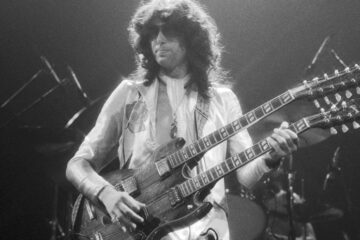Led Zeppelin were on top of the world when recording their hotly-anticipated third album, Led Zeppelin III. With the release of their first two records, the band had meteorically risen as the most exciting act on the planet, with their leader and guitarist Jimmy Page moving closer to his expansive vision for rock ‘n’ roll he had conceived when still in The Yardbirds.
Led Zeppelin III was released in October 1970. Assembled in three locations across the previous 12 months, with most of the sessions taking place at the band’s cherished creative refuge of Headley Grange, as well as at Island and Olympic Studios, it saw the quartet refine the craft and effectively lay the foundations for the creative heights they would hit later in the decade.
A broader range of instruments were employed than on their first two offerings, with bassist John Paul Jones coming into his own. After years of cutting his teeth as one of London’s most sought-after session musicians and arrangers before joining Led Zeppelin, he demonstrated his effective skills as a multi-instrumentalist. He played many different instruments on the record, including a mix of synthesisers, double bass, and the mandolin, an instrument he would become closely tied to following the success of the group’s next record, 1971’s Led Zeppelin IV. Of course, Led Zeppelin III is also smattered with his exceptional performances on the electric bass.
In keeping with tradition, the band kept everything in-house and played all the instruments themselves, refusing to enlist outside musicians. Page once again produced the album and continued to develop this component of his craft. This more expansive palette of instruments gave him more to consider when at the mixing desk, meaning that this test of his aptitude was also a necessary building block in the group’s development and journey towards achieving their creative vision. They would do so on the ensuing records, Led Zeppelin IV, Houses of the Holy and Physical Graffiti.
Led Zeppelin III was a significant turning point for the band, wherein they shed the more rudimentary blues rock of their first two albums and moved to a more diverse sonic area, drawing on folk and acoustic music more prominently whilst taking their heavier aspects up a notch. Reflecting this variety, the album includes acoustic moments such as ‘Gallows Pole’ and ‘That’s the Way’ as well as the pulsating mysticism of ‘Immigrant Song’. As ever, the band included covers, with ‘Gallows Pole’, a reworking of a traditional English folk piece, and ‘Hats Off to (Roy) Harper’, a revival of a song by great bluesman Bukka White.
Given that the first duo of Led Zeppelin records were immense successes that knocked The Beatles off their throne as the most compelling group out there, Led Zeppelin III was the most anticipated record of 1970. This was to such an extent that the advance orders in the US alone neared one million units. Famously, in the run-up to releasing the album, the group purchased a full-page spread in Melody Maker in September, saying: “Thank you for making us the world’s number one band”. The album was then released in the US in early October and later in the UK, topping the British charts immediately.
Ironically, despite being a commercial success, the album wasn’t met with the fanfare the band expected. Whilst some perceptive listeners were enthralled by the group pushing themselves into new areas, many criticised elements of the album, with this range of styles proving to be divisive. The notoriously scathing Rolling Stone critic Lester Bangs noted ‘That’s the Way’ as a “beautiful and genuinely moving” composition but slammed the heavier moments as indivisible and crude.
Given the recent rise of folk rock as a popular form, with the success of the definitive countercultural act, supergroup Crosby, Stills, Nash and Young, some criticised Led Zeppelin for imitating them. Page absolutely refused this when speaking to Rolling Stone‘s Cameron Crowe in 1975. He maintained that their previous albums had also featured acoustic numbers, so there was no way they were following the trend du jour.
Page commented: “That’s it! There you go! When the third LP came out and got its reviews, Crosby, Stills and Nash had just formed. That LP had just come out and because acoustic guitars had come to the forefront all of a sudden: LED ZEPPELIN GO ACOUSTIC! I thought, Christ, where are their heads and ears? There were three acoustic songs on the first album and two on the second.”
Regardless, the criticism of Led Zeppelin III was so hostile in places that Page did not give press interviews for 18 months after its release. He would later reveal that the objection to the album was why Led Zeppelin IV had no written information on it. He also told Uncut in 2005 that he concluded that journalists hadn’t really listened to the record and were, rather lazily, looking for “the new ‘Whole Lotta Love’” instead of objectively examining their new sounds.
Led Zeppelin III was a transatlantic number one. However, due to the lukewarm and often conflicting critiques, sales dropped after its initial peak. However, as with anything ahead of its time, society would later catch up with it, and it would be favourably reappraised as a turning point in the timeline of the British band.



